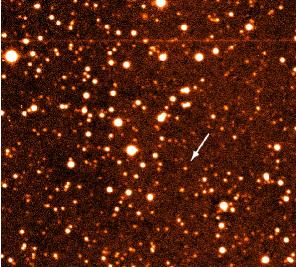Kuiper Belt
Facts about the Kuiper Belt
• The Kuiper belt is a left over debris field of ices that starts immediately after Neptune and extend farther than Pluto.
• Pluto is the largest object in the Kuiper belt.
Diameters: Range from a few feet to 1,433 miles in diameter for Pluto.
T
otal Mass: 0.4 to 4 times that of our Moon.
Compositions: Ices—frozen methane, ammonia, water and some silicates (rocks).
Distances from Sun: Varies from 2.8 to 5.1 billion miles. Neptune is 2.8 billion miles and Pluto is 3.7 billion miles from the Sun
Revolutions about Sun: Varies from 164 to 300 or more years
Atmospheres: None of the Kuiper Belt Objects have atmospheres.
Moons: Some larger Kuiper Belt bodies have moons orbiting them.
Observing with a small telescope: None of the objects in the Kuiper Belt can be seen visually with a small telescope—they are too far and faint.

The Kuiper Belt start immediately after Neptune and has a shape like a donut. The very bluish ball on the edge of the belt is Neptune. The object with the reddish orbit is Pluto and appears above the Kuiper Belt but it is part of the Belt.
